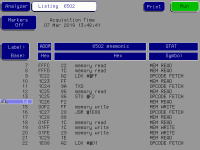Dwight Elvey
Veteran Member
Hi
I read the spec for how the relative branch works but still don't get the fine details of exactly what it does.
If the instruction branches forward or backwards when close to a page boundary.
Say the instruction has the branch instruction at xFE which way does it go for a positive or negative branch of say 8 or -8
the same for if at xFF ?
I know someone knows this.
Dwight
I read the spec for how the relative branch works but still don't get the fine details of exactly what it does.
If the instruction branches forward or backwards when close to a page boundary.
Say the instruction has the branch instruction at xFE which way does it go for a positive or negative branch of say 8 or -8
the same for if at xFF ?
I know someone knows this.
Dwight

